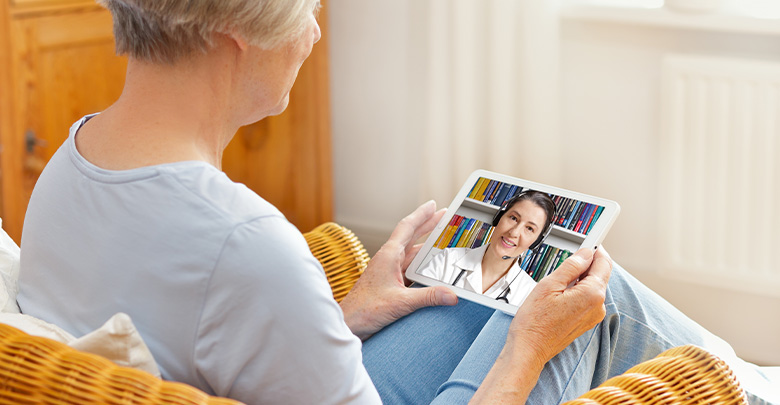How COVID-19 Restrictions Are Shaping Diabetes Care
Telemedicine offers safe access to diabetes care during the pandemic, but will this convenient option still exist when the world returns to normal?

This year has brought an incredible amount of change to the world and very few aspects of day to day life have remained untouched.
Our jobs, our coming-home routines, how we socialize, even how we shop for groceries has been affected by the COVID-19 pandemic.
Not surprisingly, the world of diabetes care isn’t immune to this change, either. And one of the areas where this change is most apparent is in how we interact with our healthcare team.
But are telehealth visits as good as in-office care when it comes to long-term diabetes management? Are we embarking on a new trend that will outlive COVID-19 because of the positive effects it has on people living with diabetes, or will these changes to diabetes care cause more harm than good before we are allowed to get back to business as usual?
Looking back on the history of telemedicine in diabetes care may give us some clues.
TeleHealth Improves Routine Diabetes Care
There have been a number of studies comparing the effects of telemedicine in diabetes care with traditional office visits. These studies typically look at both type 1 and type 2 diabetes patients and often in a rural setting or in underserved communities and use a number of metrics to measure management success.
Surprisingly, almost all of these studies reveal that patients receiving telemedical care have tighter control over their condition than those who had to travel to the doctor’s office to meet with their care team. This finding is especially true for older patients.
In many studies, patients receiving care via phone, video, or even text, had lower A1Cs than their counterparts using more traditional care methods.
Many Doctors Prefer Telehealth for Diabetes Care
For many diabetics, these findings probably don’t come as much of a surprise.
After all, meeting with your endocrinologist or care team over the phone requires less work on the patient’s part, making it more likely that the average person will follow through with their appointments.
Telehealth also lends itself to better communication than more traditional methods of care. Instead of having to call the clinic to leave a message with the receptionist, facilities utilizing telemedicine often offer alternative and more convenient means of asking questions or contacting the doctor.
But it isn’t just patients who tend to prefer the ease of telemedicine. Many doctors, especially those in the diabetes care field, have been advocating for more widespread telemedicine use in the care and management of this life-long condition.
Unlike acute conditions that require face-to-face appointments for hands-on diagnosis or other long term diseases that come with a long list of physical symptoms, most diabetes appointments are simply opportunities for your doctor to check your numbers, check your labs, and answer any questions you have.
By offering these services over the phone or through a video chat, not only can doctors see more patients per day, but they also have the opportunity to record interactions and keep better records.
The records aspect of diabetes care is even more important to the telehealth argument as diabetes tech advances.
For patients with CGMs and pumps, the days of recording your numbers by hand and bringing them with you to your appointment are long gone. Now, your doctor can access blood sugar records, carb counts, and other important details over the internet.
Analyzing and providing feedback on this kind of information certainly does not require an in-person visit. In fact, shorter, more frequent virtual visits using this wealth of data would likely only serve to improve a person’s health outcomes when compared to longer, less-frequent in-office appointments.
When Telemedicine Doesn’t Work
Of course, short, uncomplicated doctor visits are usually reserved for when things are going well.
For those suffering from severe complications or facing sudden struggles that they are at a loss to handle on their own, having a face-to-face visit with your care team may make a huge difference.
And for those who are very new to diabetes, taking in so much information over a video chat or phone call can easily become overwhelming. This kind of communication can also make establishing a personal connection with your new care team much more difficult, an issue that can lead to management problems down the road.
The Future of Diabetes Management
Certainly, in the post-COVID future, in-office diabetes care visits will have their place. But, the argument for keeping the telehealth aspect in some form is still a strong one.
I recently posed the question “How have coronavirus restrictions impacted your diabetes care?” to a type 1 diabetes group on Facebook. While about 41% of respondents worldwide said they hadn’t experienced any changes, about the same amount said they didn’t consider the changes good or bad, but simply different.
Overall, more people preferred the changes than those who disliked them.
But public opinion isn’t the only thing that will determine what diabetes care will look like after the pandemic finally ends.
Before COVID-19 struck, there were a number of restrictions to the use and implementation of telemedicine in both state law and in insurance company coverage. As the importance of social distancing became more apparent, many of these restrictions were loosened or abolished, allowing those living in cities and suburbs the same use of and coverage for telemedicine as those living in more rural locales.
For patients and doctors who enjoy the telehealth option for their diabetes care, it will likely take some legwork at the legislative level to keep these restrictions from being reimplemented once the world moves back to normal.




